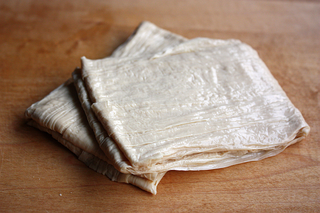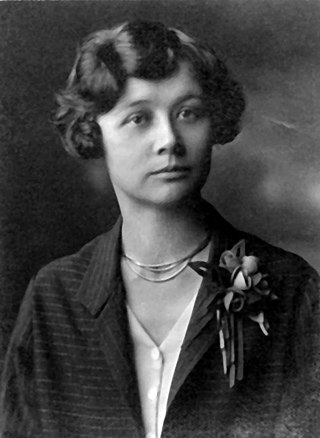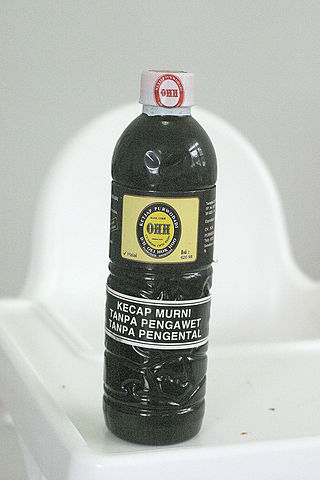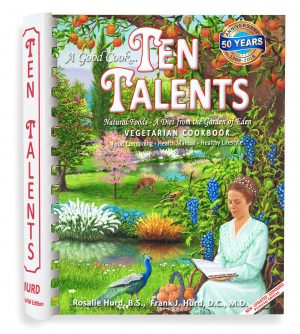Related Research Articles

The soybean, soy bean, or soya bean is a species of legume native to East Asia, widely grown for its edible bean, which has numerous uses.

Tempeh or tempe is a traditional Indonesian food made from fermented soybeans. It is made by a natural culturing and controlled fermentation process that binds soybeans into a cake form. A fungus, Rhizopus oligosporus or Rhizopus oryzae, is used in the fermentation process and is also known as tempeh starter.

Soy milk, also known as soya milk or soymilk, is a plant-based drink produced by soaking and grinding soybeans, boiling the mixture, and filtering out remaining particulates. It is a stable emulsion of oil, water, and protein. Its original form is an intermediate product of the manufacture of tofu. Originating in China, it became a common beverage in Europe and North America in the latter half of the 20th century, especially as production techniques were developed to give it a taste and consistency more closely resembling that of dairy milk. Soy milk may be used as a substitute for dairy milk by individuals who are vegan or lactose intolerant.

Amazake is a traditional sweet, low-alcohol or non-alcoholic Japanese drink made from fermented rice. Amazake dates from the Kofun period, and it is mentioned in the Nihon Shoki. It is part of the family of traditional Japanese foods made using the koji mold Aspergillus oryzae, which also includes miso, soy sauce, and sake.

Tofu skin, Yuba, beancurd skin, beancurd sheet, or beancurd robes is a food product made from soybeans. During the boiling of soy milk, in an open shallow pan, a film or skin composed primarily of a soy protein-lipid complex forms on the liquid surface. The films are collected and dried into yellowish sheets known as tofu skin. Since tofu skin is not produced using a coagulant, it is not technically a proper tofu; however, it does have similar texture and flavor to some tofu products.

Fermented tofu is a Chinese condiment consisting of a form of processed, preserved tofu used in East Asian cuisine. The ingredients typically are soybeans, salt, rice wine and sesame oil or vinegar. In mainland China the product is often freshly distributed. In overseas Chinese communities living in Southeast Asia, commercially packaged versions are often sold in jars containing blocks 2- to 4-cm square by 1 to 2 cm thick soaked in brine with select flavorings.

Okara, soy pulp, or tofu dregs is a pulp consisting of insoluble parts of the soybean that remain after pureed soybeans are filtered in the production of soy milk and tofu. It is generally white or yellowish in color. It is part of the traditional cuisines of Japan, Korea, and China. Since the 20th century, it has been used in the vegetarian cuisines of Western nations.

Tofu is a food prepared by coagulating soy milk and then pressing the resulting curds into solid white blocks of varying softness: silken, soft, firm, extra firm. Tofu is also known as bean curd in English. It is a traditional component of East Asian and Southeast Asian cuisines that has also been consumed in China for over 2,000 years. In modern Western cooking, it is most often treated as a meat substitute.

Mildred Mathilda Lager was an American pioneer of natural foods and health food.

Semur is an Indonesian meat stew braised in thick brown gravy. It is commonly found in Indonesian cuisine. The main ingredients in the gravy are sweet soy sauce, shallots, onions, garlic, ginger, candlenut, nutmeg, and cloves.

Rynn Berry was an American author and scholar on vegetarianism and veganism, as well as a pioneer in the animal rights and vegan movements.

Wotou or wowotou, also called Chinese cornbread, is a type of steamed bread made from cornmeal in Northern China.

Sweet soy sauce is a sweetened aromatic soy sauce, originating in Indonesia, which has a darker color, a viscous syrupy consistency, and a molasses-like flavor due to the generous addition of palm sugar or jaggery. Kecap manis is widely used with satay. It is similar to, though finer in flavor than, Chinese Tianmian sauce (tianmianjiang). It is by far the most popular type of soy sauce employed in Indonesian cuisine and accounts for an estimated 90 percent of the nation's total soy sauce production.

Ten Talents is a vegetarian and vegan cookbook originally published in 1968 by Rosalie Hurd and Frank J. Hurd. At the time, it was one of the few resources for vegetarian and vegan cooks. The cookbook promotes Christian vegetarianism and a Bible-based diet, in keeping with teachings of the Seventh-day Adventist Church. By 1991, the 750-recipe cookbook was entering its 44th printing and had sold more than 250,000 copies. An expanded edition with more than 1,000 recipes was issued in 2012.

The Farm Vegetarian Cookbook is a vegan cookbook by Louise Hagler, first published in 1975. It was influential in introducing Americans to tofu, included recipes for making and using tempeh and other soy foods, and became a staple in vegetarian kitchens.

Harry Willis Miller was an American physician, thyroid surgeon and Seventh-day Adventist missionary. Miller was a vegetarian and pioneer in the development of soy milk.

Otto Heinrich Carque was a French–American businessman, fruit grower, naturopath, raw foodist, vegetarian and writer. He was the first to use the term natural food.
Akiko Aoyagi is an American cookbook author and artist. She is best known as the recipe developer, illustrator, and co-author of the soy-based cookbook series The Book of Tofu (1975), The Book of Miso (1976), and The Book of Tempeh (1979), that had a strong impact on the natural foods movement within the American counterculture.
References
- ↑ "Interview with Bill Shurtleff". cuke.com. Retrieved 5 January 2022.
- ↑ Clarke, Christina (1981). Cook with Tofu. New York: Avon. p. 13. ISBN 0-380-77941-2.
With the appearance of The Book of Tofu by William Shurtleff and Akiko Aoyagi in late 1975, non-oriental Americans began to recognize the remarkable qualities of this food and to make it themselves. The authors included not only oriental recipes, but also recipes that used tofu in traditional Western dishes. They also discussed in detail how one might open a tofu shop in this country [the United States]. Many of the tofu shops established by non-Orientals since then have been inspired by The Book of Tofu and by personal encouragement from the authors themselves.
- 1 2 3 4 Sass, Lorna (September 24, 1980). "A Couple on a Tofu Mission in the West (p.C3)". New York Times. ProQuest 121124218.
- ↑ Hamlin, Suzanne (August 9, 1995). "Do You Speak Tofu Or Miso Yet?". New York Times. ProQuest 109526405.
- ↑ Shurtleff, Benjamin; Shurtleff, N. B. (1912). Descendants of William Shurtleff of Plymouth and Marshfield, Massachusetts. New York Public Library. Revere, Mass. [n.p.]
- ↑ "About Us - about the authors". SoyInfo Center. Retrieved November 15, 2021.
- 1 2 3 4 "The Plowboy Interview: Bill Shurtleff and Akiko Aoyagi". Mother Earth News. 1977-03-01. Retrieved 2023-03-28.
- 1 2 Kauffman, Jonathan (2018). Hippie Food: How Back-To-The-Landers, Longhairs, and Revolutionaries Changed the Way We Eat. William Morrow. p. 145. ISBN 978-0062437303.
- ↑ Shurtleff, William; Aoyagi, Akiko (1975). The Book of Tofu (1979 revised ed.). New York: Ballantine Books. p. vii. ISBN 0-345-30806-9.
- 1 2 Kauffman, Jonathan (2018). Hippie Food: How Back-To-The-Landers, Longhairs, and Revolutionaries Changed the Way We Eat. William Morrow. p. 146. ISBN 978-0062437303.
- 1 2 3 Berry, Rynn (1995). Famous Vegetarians and Their Favorite Recipes: Lives and Lore from Buddha to the Beatles. Pythagorean Publishers. pp. 174–175. ISBN 0962616915.
- 1 2 3 "Home page". SoyInfo Center. Retrieved November 15, 2021.
- ↑ Kauffman, Jonathan (2018). Hippie Food: How Back-To-The-Landers, Longhairs, and Revolutionaries Changed the Way We Eat. William Morrow. p. 161. ISBN 978-0062437303.
- ↑ "About Us". SoyInfo Center. Retrieved November 15, 2021.
- ↑ Shurtleff, William; Aoyagi, Akiko (1979). The Book of Tempeh (Second ed.). New York: Harper & Row. pp. 9–10. ISBN 0-06-091265-0.
- ↑ Roth, Matthew (2018). Magic Bean: The Rise of Soy in America. Lawrence, KS: University Press of Kansas. p. 210. ISBN 9780700626342.
- ↑ Roberts, Sam (March 7, 2021). "David Mintz, 89, Whose Tofutti made Bean Curd Cool: (Biography)". New York Times. No. Late Edition (East Coast). ProQuest 2497641714.
- ↑ Kauffman, Jonathan (2018). Hippie Food: How Back-To-The-Landers, Longhairs, and Revolutionaries Changed the Way We Eat. William Morrow. p. 166. ISBN 978-0062437303.
- ↑ Kauffman, Jonathan (2018). Hippie Food: How Back-To-The-Landers, Longhairs, and Revolutionaries Changed the Way We Eat. William Morrow. p. 164. ISBN 978-0062437303.
- ↑ Silberman, Steve (2018-01-18). "'Hippie Food,' by Jonathan Kauffman". San Francisco Chronicle . Retrieved 2023-03-28.
- ↑ Berry, Rynn (1995). Famous Vegetarians and Their Favorite Recipes: Lives and Lore from Buddha to the Beatles. Pythagorean Publishers. p. x-xii. ISBN 0962616915.
- 1 2 Berry, Rynn (1995). Famous Vegetarians and Their Favorite Recipes: Lives and Lore from Buddha to the Beatles. Pythagorean Publishers. p. 171. ISBN 0962616915.
- ↑ Abraham, Laura (2018-03-09). "Discovering Treasures While Processing the Rynn Berry, Jr. Papers". North Carolina State University Libraries. Retrieved 2023-03-28.
- ↑ "STS Oberly Award for Bibliography in the Agricultural or Natural Sciences". Association of College and Research Libraries. American Library Association. 12 February 2009. Retrieved November 24, 2021.
- ↑ Sheridan, Margaret (1996-09-26). "Soy Talk With Father Tofu". Los Angeles Times . Retrieved 2023-03-28.
- ↑ Aoyagi, Akiko (2023-01-27). "Akiko Aoyagi Shurtleff". Facebook. Retrieved 2023-03-28.
- ↑ "Introducing SoyInfo Center". soyinfocenter.com. Retrieved 2023-03-29.
